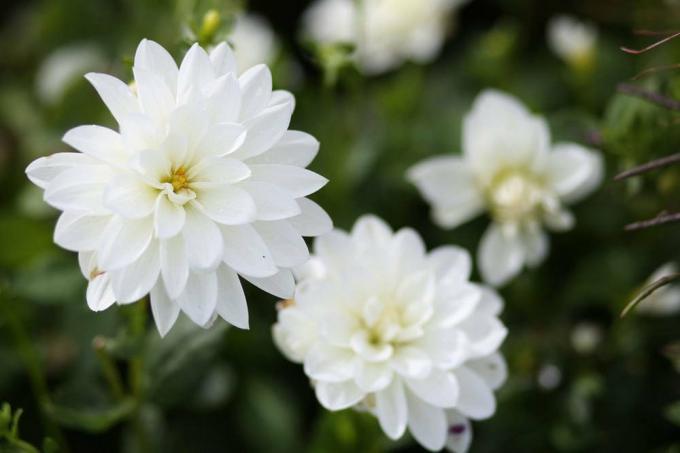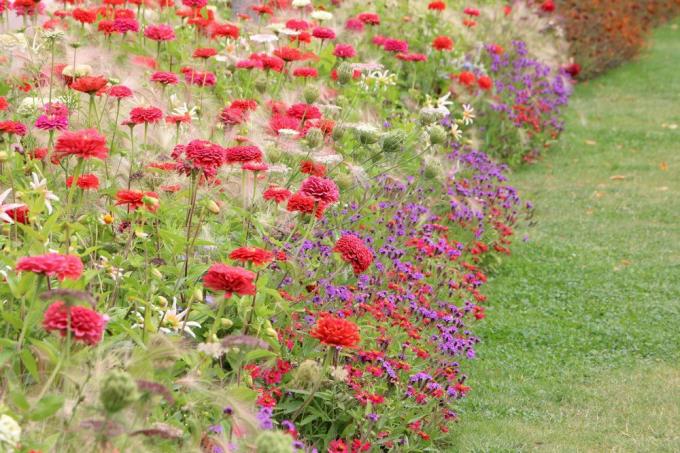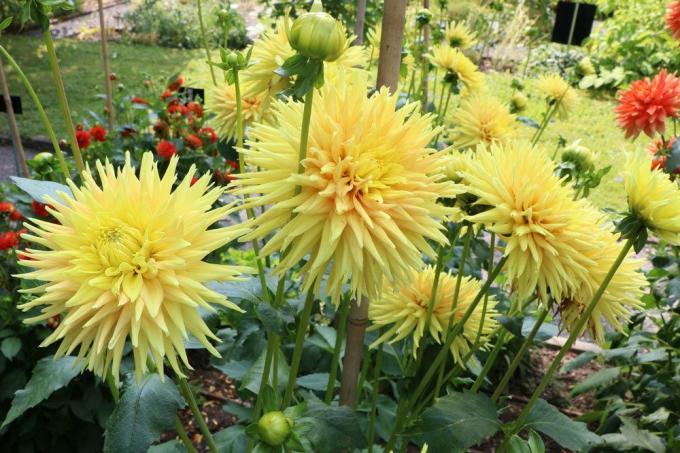
table of contents
- Planting time
- Prefer dahlia bulbs
- Plant spacing
- Planting depths
- Instructions for planting
Dahlias are one of the most magnificent summer flowers. Their large and sometimes heavy flower heads with their unusual colors and color gradients provide spectacular splashes of color in the garden or on the balcony and terrace. They bloom from summer until the first frost. The heights of the individual varieties are also different. What all varieties have in common, however, is the lack of frost resistance. It is all the more important to pay attention to the right planting time.
Planting time
Best time to plant
Due to the lack of winter hardiness, you should generally wait until spring before planting. The right time depends on whether it is the tubers or young plants or driven dahlias. Dahlia tubers can be planted in the ground from late April / early May. At this point in time, possible night frosts can usually no longer harm them, as they no longer penetrate the ground. The situation is different with young plants or those that have been grown earlier. You shouldn't be before the ice saints, i.e. not before the 15th. May be planted, because the sensitive roots would not withstand frost.

Prefer dahlia bulbs
- by pulling out the dahlias, shorten the waiting time until flowering
- early budding in winter quarters, another reason for preculture
- overwintering that is too warm is usually the cause of early budding
- Plant these tubers as soon as possible
- otherwise, so-called Geiltriebe will form
- best time from around February / March
- Put the tubers in a moist substrate to prepare them
- Put the whole thing in a warm place with 15-20 degrees
- for example on the windowsill, in the cold frame or in the winter garden
- Get young plants used to sunlight and outside temperatures after they have sprouted
- put it in a sheltered place outdoors on cloudy days
- after the ice saints, from mid-May, plant out in the garden
It is best to put specimens that are kept permanently in the bucket and later beautify the balcony or terrace in suitable pots. So you can save yourself repotting. In the spring they can then be put out permanently.
Tip: Driven plants are usually more robust and less prone to snail damage. In addition, this lead in growth leads to more luxuriant blooms.
Plant spacing
These magnificent permanent bloomers need sufficient space, they should not be too close together. Otherwise they could hinder each other's growth. The optimal planting distance depends on the respective dahlia variety or whether it is high (up to 180 cm), medium-high (up to 120 cm) or low-growing (30 - 50 cm) varieties.

The taller the dahlias get, the greater the distance between the tubers should be. In general, they should be about half to a third of the final height. This results in a planting distance of around 30 - 40 cm for low specimens, 60 - 70 cm for medium-high ones and a distance of up to 100 cm for tall varieties.
Planting depths
The correct planting depth depends on the one hand on the type of dahlia and the size of the tuber and also on whether it is tubers or young plants. Tubers should be inserted so deep that they are about 3 - 5 cm covered with soil. If you set them too deep, they will sprout much worse. For young or For plants grown in front, care should be taken that the crown sits directly above the surface of the earth after it has been planted.
Tip: The rule of thumb for determining the planting depth of tubers is that they should be covered with soil twice to three times their size.
Instructions for planting
In the garden
For planting, choose a sunny, sheltered location with normal, deep and well-drained soil. Waterlogged soils are unsuitable. Heavy soils are loosened beforehand with coarse-grained sand. Slightly sandy soil can be improved by adding compost. Sandy, slightly acidic soils with a pH value of 6.5 are ideal.
- Get the tubers out of their winter quarters in spring
- Remove old remains of earth and sort out rotten tubers
- It is best to cut large specimens with a sharp knife
- if not, mainly leaves and fewer flowers are produced
- each section should have buds or shoots
- Then allow the interfaces to air dry for 2 - 3 days
- this is to prevent rot formation
- Tubers usually lose a lot of water during winter
- however, do not water if possible
- in the still cold, damp earth there would then be a risk of rot
- For planting, dig a deep hole for each tuber
- Put a handful of horn shavings, some compost or cattle manure in each of the planting holes
- Use dahlias taking into account the planting distance and planting depth
- Cover the tubers with soil and press them lightly
- water the first time when the shoot can be seen
In the case of medium-sized and large dahlia varieties, it is advisable to use appropriate support rods when planting and to tie the dahlias loosely to them with sufficient play. This is to prevent them from bending over during flowering due to their size and the relatively heavy flower heads in windy weather. The respective supports should, if possible, be dug into the ground before the tubers are planted. be beaten. In the opposite case, it could easily happen that the tubers are injured in the process.

Tip: Anyone who has a problem with voles in their garden should use the dahlias to protect them from damage by eating or Total loss by means of a sufficiently large, close-meshed wire basket or wire mesh in the ground set.
In the bucket
As an alternative to the garden, dahlias can also be cultivated very well in pots or tubs. Depending on the type of dahlia, the respective planter should have a capacity of at least 7.5 liters and a diameter of 25 - 50 cm. Any well-drained and nutrient-rich potting soil is suitable as a substrate. A drainage layer made of potsherds or coarse gravel is placed on top of the drainage holes and then the substrate. The tubers are placed in the middle at the appropriate planting depth and then filled with soil. Suitable supports should also be used when planting tubs.
